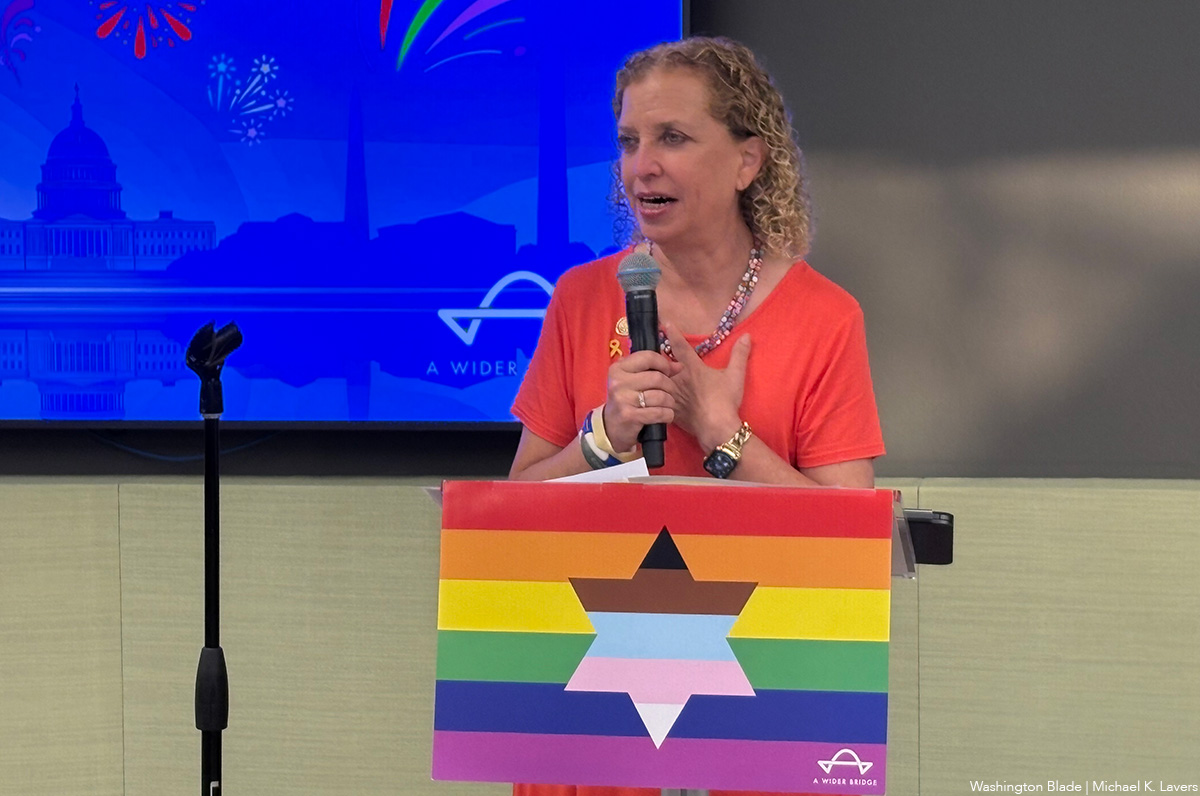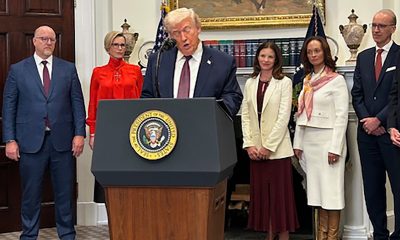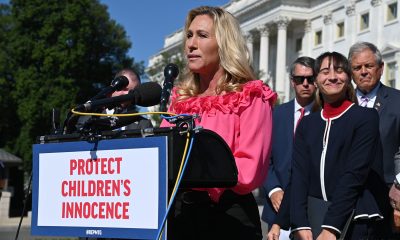National
Bi-national couple files class-action suit against DOMA
Same-sex couple faces relocation to the Philippines
A bi-national couple in California and their son have filed a lawsuit against the Defense of Marriage Act in court in attempt to avoid separation or relocation to the Philippines.
The lawsuit, Aranas v. Napolitano, was filed Thursday by the Center for Human Rights on Constitutional Law on behalf of a Filipino foreign national along with her 25-year-old son and her U.S. citizen spouse. The class-action suit is pending before the U.S. District Court for the Central District of California.
Jane DeLeon, an immigrant from the Philippines who came to the United States in 1989, has lived with her U.S. citizen partner in California, Irma Rodriguez, for twenty years. They were married in 2008 prior to passage of Proposition 8. DeLeon had her son, Martin Aranas, in a previous marriage with a man and he came to the United States when he was nine years old. His legal status is dependent on his mother’s.
DeLeon and Aranas had temporary lawful status for several years while their visa applications were being processed. DeLeon was approved for an immigrant visa based on her employment, but because she entered the country using the name of her then common-law husband, she needed a I-601 waiver from U.S. Citizenship and Immigration Service to retain legal status.
According to the lawsuit, DeLeon tried many avenues to obtain the waiver, but was denied in every attempt. Ultimately, DeLeon made the case the relocation to the Philippines would cause undue hardship for the couple. The complaint says Rodriguez suffers from hypertension and the medication she takes, Ultram, isn’t available in country. The lawsuit also cites the State Department annual human rights report and its assertion that the Philippines can be a hostile place for LGBT people.
Nonetheless, on Nov. 9, the federal government denied the application, citing Section 3 of DOMA, which prohibits federal recognition of same-sex marriage. According to a news statement, DeLeon was advised that her temporary lawful status was revoked and if she didn’t depart the country within 12 months she would be barred from reentry for a minimum of ten years.
In the statement, DeLeon said she and her family “pray that the administration will change its mind” and grant her relief so that she’s able to stay within the country.
“Irma and I have committed to each other for the rest of our lives,” DeLeon said. “We now face being forced to move to the Philippines or breaking up our family only because we are legally married women. We would face persecution in the Philippines because we are a same sex couple, not to mention dire poverty, separation from our extended families who live here, and lack of access to medical treatment Irma needs.”
Aranas also said he wants to see the administration change its decision so both he and his mother can remain together in the United States.
“I have attended school here and continue to attend school while working part-time,” Aranas said. “My legalization depends on my mother’s case. After many years of having temporary legal status, I now face being in ‘illegal’ status only because my mother is in a same sex marriage. I hope and pray that President Obama will allow me and the hundreds or thousands of children of gay married couples to continue living here with some legal protection until the courts decide whether denying our parents immigration benefits is constitutional.”
Plaintiffs contend DOMA is unconstitutional because it violates the due process and equal protection guarantees of the Fifth Amendment of the U.S. Constitution. The prayer for relief calls for the court to certify a class of similarly situated same-sex married couples and to rule that applying DOMA in this matter is unlawful. Additionally, the lawsuit asks for a temporary injunction preventing the federal government from removing or detaining plaintiffs or denying them access to employment.
Peter Schey, an attorney with the Center for Human Rights and Constitutional Law, said he hopes the lawsuit prompts the administration to change its policy and offer across the board relief for DeLeon’s family and those who are similarly situated.
“To discriminate against this population by requiring that they live underground, work illegally, or worse be deported, while the courts address the constitutionality of DOMA is unconscionable,” Schey said. “If President Obama understood that undocumented youth are entitled to temporary protection from deportation while Congress grabbles with their status, he should understand that same sex married couples are entitled to temporary protection from deportation while the courts decide if they agree with his administration that DOMA is unconstitutional.”
Lavi Soloway, an immigration attorney and founder of the Stop the Deportations, said the case is the sixth to be filed in federal court in which a married bi-national couple has challenged DOMA. Soloway, who isn’t involved in the litigation, said the lawsuit takes its place at the back of line behind nearly 20 other cases challenging DOMA and predicted that the two cases on appeal to the Supreme Court would be resolved by Summer 2013 — much sooner than the resolution of the latest case.
Still, Soloway said the filing of the lawsuit “highlights the urgent need” for the Obama administration to act on its own accord and put marriage-based green card application by gay families on hold in addition to instituting a moratorium on DOMA-based deportations.
“The Obama administration has refused to act to protect LGBT families impacted by DOMA in the immigration context, despite strenuous efforts by members of both the House and Senate to urge implementation of these remedies,” Soloway said. “Thousands of gay and lesbian Americans struggle every day with the crisis of expiring visas, separation, exile, and deportation caused solely by DOMA. This can end now if the Obama administration uses the power of the executive branch to implement remedies to protect our families until DOMA is gone.”
The Department of Homeland Security has repeatedly said it would continue to enforce to DOMA in the face of calls to hold marriage-based green cards for same-sex couples in abeyance. The administration has said it would examine potential deportations on a case-by-case basis and would consider low priority individuals with ties to the community, including LGBT families.

A Wider Bridge on Friday announced it will shut down at the end of the month.
The group that “mobilizes the LGBTQ community to fight antisemitism and support Israel and its LGBTQ community” in a letter to supporters said financial challenges prompted the decision.
“After 15 years of building bridges between LGBTQ communities in North America and Israel, A Wider Bridge has made the difficult decision to wind down operations as of Dec. 31, 2025,” it reads.
“This decision comes after challenging financial realities despite our best efforts to secure sustainable funding. We deeply appreciate our supporters and partners who made this work possible.”
Arthur Slepian founded A Wider Bridge in 2010.
The organization in 2016 organized a reception at the National LGBTQ Task Force’s Creating Change Conference in Chicago that was to have featured to Israeli activists. More than 200 people who protested against A Wider Bridge forced the event’s cancellation.
A Wider Bridge in 2024 urged the Capital Pride Alliance and other Pride organizers to ensure Jewish people can safely participate in their events in response to an increase in antisemitic attacks after Hamas militants attacked Israel on Oct. 7, 2023.
The Jewish Telegraphic Agency reported authorities in Vermont late last year charged Ethan Felson, who was A Wider Bridge’s then-executive director, with lewd and lascivious conduct after alleged sexual misconduct against a museum employee. Rabbi Denise Eger succeeded Felson as A Wider Bridge’s interim executive director.
A Wider Bridge in June honored U.S. Rep. Debbie Wasserman Schultz (D-Fla.) at its Pride event that took place at the Capital Jewish Museum in D.C. The event took place 15 days after a gunman killed two Israeli Embassy employees — Yaron Lischinsky and Sarah Milgrim — as they were leaving an event at the museum.
“Though we are winding down, this is not a time to back down. We recognize the deep importance of our mission and work amid attacks on Jewish people and LGBTQ people – and LGBTQ Jews at the intersection,” said A Wider Bridge in its letter. “Our board members remain committed to showing up in their individual capacities to represent queer Jews across diverse spaces — and we know our partners and supporters will continue to do the same.”
Editor’s note: Washington Blade International News Editor Michael K. Lavers traveled to Israel and Palestine with A Wider Bridge in 2016.
The White House
‘Trump Rx’ plan includes sharp cuts to HIV drug prices
President made announcement on Friday

President Donald Trump met with leaders from some of the world’s largest pharmaceutical companies at the White House on Friday to announce his new “Trump Rx” plan and outline efforts to reduce medication costs for Americans.
During the roughly 47-minute meeting in the Roosevelt Room, Trump detailed his administration’s efforts to cut prescription drug prices and make medications more affordable for U.S. patients.
“Starting next year, American drug prices will come down fast, furious, and will soon be among the lowest in the developed world,” Trump said during the meeting. “For decades, Americans have been forced to pay the highest prices in the world for prescription drugs by far … We will get the lowest price of anyone in the world.”
Trump signed an executive order in May directing his administration “to do everything in its power to slash prescription drug prices for Americans while getting other countries to pay more.”
“This represents the greatest victory for patient affordability in the history of American health care, by far, and every single American will benefit,” he added.
Several pharmaceutical executives stood behind the president during the announcement, including Sanofi CEO Paul Hudson, Novartis CEO Vas Narasimhan, Genentech CEO Ashley Magargee, Boehringer Ingelheim (USA) CEO Jean-Michel Boers, Gilead Sciences CEO Dan O’Day, Bristol Myers Squibb General Counsel Cari Gallman, GSK CEO Emma Walmsley, Merck CEO Robert Davis, and Amgen Executive Vice President Peter Griffith.
Also in attendance were Health and Human Services Secretary Robert F. Kennedy Jr., Commerce Secretary Howard Lutnick, Centers for Medicare and Medicaid Services Administrator Mehmet Oz, and Food and Drug Administration Commissioner Marty Makary.
Under the Trump Rx plan, the administration outlined a series of proposed drug price changes across multiple companies and therapeutic areas. Among them were reductions for Amgen’s cholesterol-lowering drug repatha from $573 to $239; Bristol Myers Squibb’s HIV medication reyataz from $1,449 to $217; Boehringer Ingelheim’s type 2 diabetes medication jentadueto from $525 to $55; Genentech’s flu medication xofluza from $168 to $50; and Gilead Sciences’ hepatitis C medication epclusa from $24,920 to $2,425.
Additional reductions included several GSK inhalers — such as the asthma inhaler advair diskus 500/50, from $265 to $89 — Merck’s diabetes medication januvia from $330 to $100, Novartis’ multiple sclerosis medication mayzent from $9,987 to $1,137, and Sanofi’s blood thinner plavix from $756 to $16. Sanofi insulin products would also be capped at $35 per month’s supply.
These prices, however, would only be available to patients who purchase medications directly through TrumpRx. According to the program’s website, TrumpRx “connects patients directly with the best prices, increasing transparency, and cutting out costly third-party markups.”
Kennedy spoke after Trump, thanking the president for efforts to lower pharmaceutical costs in the U.S., where evidence has shown that drug prices — including both brand-name and generic medications — are nearly 2.78 times higher than prices in comparable countries. According to the Pharmaceutical Research and Manufacturers of America, roughly half of every dollar spent on brand-name drugs goes to entities that play no role in their research, development, or manufacturing.
“This is affordability in action,” Kennedy said. “We are reversing that trend and making sure that Americans can afford to get the life-saving solutions.”
Gilead CEO Dan O’Day also spoke about how the restructuring of drug costs under TrumpRx, combined with emerging technologies, could help reduce HIV transmission — a virus that, if untreated, can progress to AIDS. The LGBTQ community remains disproportionately affected by HIV.
“Thank you, Mr. President — you and the administration,” O’Day said. “I think this objective of achieving the commitment to affordability and future innovation is extraordinary … We just recently launched a new medicine that’s only given twice a year to prevent HIV, and we’re working with Secretary Kennedy and his entire team, as well as the State Department, as a part of your strategy to support ending the epidemic during your term.
“I’ve never been more optimistic about the innovation that exists across these companies and the impact this could have on America’s health and economy,” he added.
Trump interjected, asking, “And that’s working well with HIV?”
“Yes,” O’Day replied.
“It’s a big event,” Trump said.
“It literally prevents HIV almost 100 percent given twice a year,” O’Day responded.
A similar anti-HIV medication is currently prescribed more than injectable form mentioned by O’Day. PrEP, is a medication regimen proven to significantly reduce HIV infection rates for people at high risk. Without insurance, brand-name Truvada can cost roughly $2,000 per month, while a generic version costs about $60 per month.
Even when medication prices are reduced, PrEP access carries additional costs, including clinic and laboratory fees, office visits, required HIV and sexually transmitted infection testing, adherence services and counseling, and outreach to potentially eligible patients and providers.
According to a 2022 study, the annual total cost per person for PrEP — including medication and required clinical and laboratory monitoring — is approximately $12,000 to $13,000 per year.
The TrumpRx federal platform website is now live at TrumpRx.gov, but the program is not slated to begin offering reduced drug prices until January.
The White House
EXCLUSIVE: Democracy Forward files FOIA lawsuit after HHS deadnames Rachel Levine
Trans former assistant health secretary’s name changed on official portrait

Democracy Forward, a national legal organization that works to advance democracy and social progress through litigation, policy and public education, and regulatory engagement, filed a lawsuit Friday in federal court seeking to compel the U.S. Department of Health and Human Services to release information related to the alteration of former Assistant Secretary for Health Adm. Rachel Levine’s official portrait caption.
The lawsuit comes in response to the slow pace of HHS’s handling of multiple Freedom of Information Act requests — requests that federal law requires agencies to respond to within 20 working days. While responses can take longer due to backlogs, high request volumes, or the need for extensive searches or consultations, Democracy Forward says HHS has failed to provide any substantive response.
Democracy Forward’s four unanswered FOIA requests, and the subsequent lawsuit against HHS, come days after someone in the Trump-Vance administration changed Levine’s official portrait in the Hubert H. Humphrey Building to display her deadname — the name she used before transitioning and has not used since 2011.
According to Democracy Forward, HHS “refused to release any records related to its morally wrong and offensive effort to alter former Assistant Secretary for Health Admiral Rachel Levine’s official portrait caption.” Levine was the highest-ranking openly transgender government official in U.S. history and served as assistant secretary for health and as an admiral in the U.S. Public Health Service Commissioned Corps from 2021 to 2025.
Democracy Forward President Skye Perryman spoke about the need to hold the Trump-Vance administration accountable for every official action, especially those that harm some of the most targeted Americans, including trans people.
“The question every American should be asking remains: what is the Trump-Vance administration hiding? For an administration that touts its anti-transgender animus and behavior so publicly, its stonewalling and silence when it comes to the people’s right to see public records about who was behind this decision is deafening,” Perryman said.
“The government’s obligation of transparency doesn’t disappear because the information sought relates to a trailblazing former federal official who is transgender. It’s not complicated — the public is entitled to know who is making decisions — especially decisions that seek to alter facts and reality, erase the identity of a person, and affect the nation’s commitment to civil rights and human dignity.”
“HHS’s refusal to respond to these lawful requests raises more serious concerns about transparency and accountability,” Perryman added. “The public has every right to demand answers — to know who is behind this hateful act — and we are going to court to get them.”
The lawsuit also raises questions about whether the alteration violated federal accuracy and privacy requirements governing Levine’s name, and whether the agency improperly classified the change as an “excepted activity” during a lapse in appropriations. By failing to make any determination or produce any records, Democracy Forward argues, HHS has violated its obligations under federal law.
The case, Democracy Forward Foundation v. U.S. Department of Health and Human Services, was filed in the U.S. District Court for the District of Columbia. The legal team includes Anisha Hindocha, Daniel McGrath, and Robin Thurston.
The Washington Blade reached out to HHS, but has not received any comment.
The lawsuit and four FOIA requests are below:



















